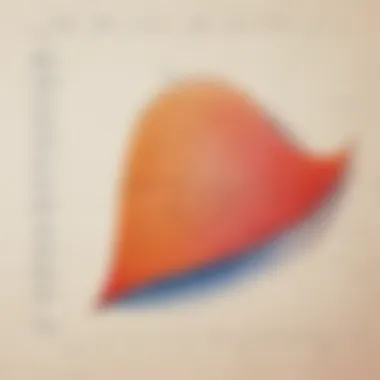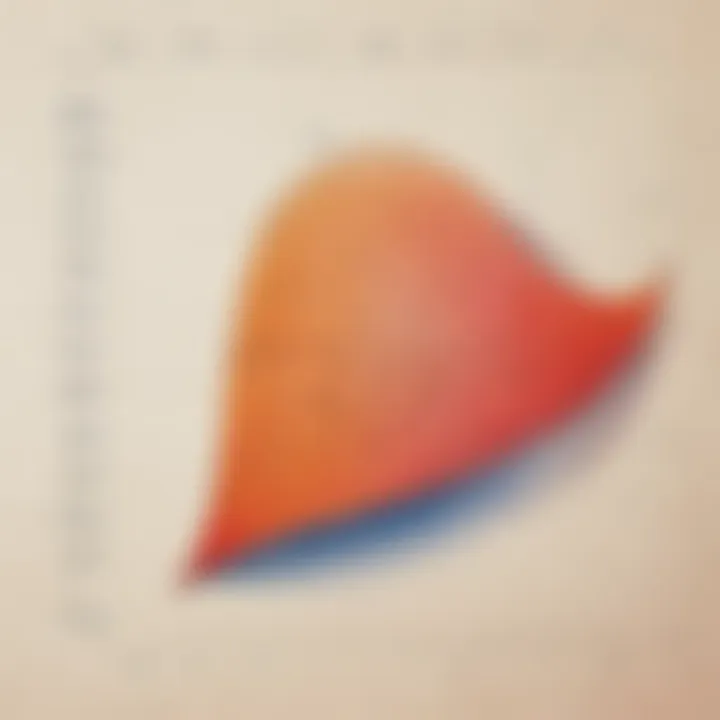Understanding the Concept of Mean in Mathematics


Intro
The concept of mean in mathematics plays a crucial role in various fields, such as statistics, finance, and everyday life. The mean, often referred to as the average, provides a simple yet powerful way to summarize a set of numbers. This article is aimed at young learners, parents, and caregivers, making it easier to grasp the basic principles of mean while providing engaging examples and practical applications. By understanding this concept, readers can develop strong mathematical foundations that can be applied in various situations.
Creative Activities
Hands-on activities can enhance the learning experience, allowing children to explore the concept of the mean through creative methods. Below, we outline several engaging craft ideas paired with simple instructions.
Craft Ideas
- Mean Bar Graphs: Use colorful paper to create bar graphs that represent different sets of numbers. Students can calculate the mean and visually see how it operates.
- Mean Jar: Fill a clear jar with different sized objects, like marbles or blocks, and have kids predict the average size before measuring them.
Step-by-Step Guides
Creating mean bar graphs:
- Gather materials like colored paper, scissors, and a ruler.
- Choose a set of numbers (e.g., test scores, ages).
- Draw the axes and label them accordingly on the colored paper.
- Create bar heights based on the numbers and calculate the mean for understanding.
Understanding the mean jar:
- Collect various objects of different sizes.
- Have predictions made about their average size.
- Measure out the individual sizes and calculate the mean to find out if predictions were close.
Educational Value
Engaging in these activities offers numerous educational benefits. They help simultaneously develop critical thinking and analytical skills. This deeper understanding of the mean and averages can lay the groundwork for more complex mathematical concepts in the future.
Fun Quizzes
Quizzes offer an interactive way to reinforce knowledge about the mean and its applications. Here's how quizzes can be used effectively.
Quiz Topics
Some topics available might include:
- Understanding what the mean is.
- Calculating the mean of different data sets.
- Identifying where the mean can be applied in real life.
Question Types
The quizzes may include:
- Multiple-choice questions: Select the correct answer that represents the calculated mean.
- Fill-in-the-blank questions: Complete statements about the concept of mean.
- True or False: Determine statements about means that reflect their understanding of the topic.
Knowledge Reinforcement
By engaging in quizzes, learners positively reinforce what they have learned. This method allows children to assess their understanding and congregation of knowledge, making the concept of mean more retainable.
Additional Thoughts
Throughout this article, we have explored several facets of the mean in mathematics. Our aim was to break down complex terms and formulations to ensure a solid foundation of understanding for young audience members. Activities like crafting, quizzes, and practical examples show readers how to apply mean in real-world contexts.
Thus, understanding the mean opens up new avenues of analysis in everyday scenarios. Mastery of this foundation not only fosters mathematical proficiency but also enhances problem-solving capabilities necessary for future learning.
Learning about the mean can be a steppingstone to advanced mathematical studies, where concepts converge to form a bigger picture. For further reading, valuable resources can be accessed through Wikipedia, Britannica, or engaging in discussions on platforms like Reddit.
Preamble to the Mean
Understanding the mean is fundamental in mathematics. The mean, often called the average, gives a simple way to summarize a set of numbers. This oncept helps students to grasp larger ideas in statistics and data analysis. Knowing how to calculate and interpret the mean is a skill used frequently in daily decisions, from budgeting to collecting data.
Many educators utilize examples from real life to illustrate these concepts, tying in relatable situations. When young learners see how the mean applies in their lives, they often find it easier to comprehend. Thus, the study of mean sets a solid foundation for more advanced mathematical concepts. Developing an early understanding of it promotes mathematical literacy and numeracy.
Definition of the Mean
The mean is calculated by taking the sum of a list of numbers and dividing by the quantity of those numbers. It presents a single value that represents the central point of a given data set. Here is the formula:
Mean = (Sum of all values) / (Number of values)
In simple terms, the mean can be thought of as
Types of Means


Understanding different types of means is crucial in mathematics. Each type serves its purpose based on the nature of the data and the context of the analysis. Knowing when to use decomposition not only refines calculations but also shapes interpretations. Here are the primary types we will examine: Arithmetic Mean, Geometric Mean, and Harmonic Mean. These measures help us summarize and extract relevant conclusions from data sets.
Arithmetic Mean
The arithmetic mean is the most common type of average. It is calculated by summing all the values in a data set and then dividing this sum by the total number of values. For example, in a classroom setting, the scores of students in a test can be represented. If five students scored 80, 90, 100, 75, and 85, we compute it this way:
- Add the scores: 80 + 90 + 100 + 75 + 85 = 430.
- Divide by the number of students: 430 ÷ 5 = 86.
Thus, the arithmetic mean score is 86, indicating the class's overall performance.
The arithmetic mean simplifies complex datasets into a single representative value.
This type is particularly useful when data is evenly distributed and there are no extreme values.
Geometric Mean
Geometric mean offers a different perspective. It is appropriate for data that vary multiplicatively instead of additively. To find the geometric mean, multiply all the values together and then take the nth root (where n is the total number of values). For instance, suppose we analyze the growth rates over time. If growth rates were 2%, 3%, and 4%, the geometric mean is computed as follows:
- Convert percentages to decimals: 1.02, 1.03, 1.04.
- Multiply them: 1.02 × 1.03 × 1.04 = 1.091224.
- Take the cube root:
- The final result: approx 1.03 or 3% growth.
The geometric mean accurately reflects average rates of growth better than the arithmetic mean in many scenarios, especially in finance and biology.
Harmonic Mean
The harmonic mean is less known but quite useful depending on the data types, especially in dealing with rates or ratios. This mean emphasizes lower values more than higher ones. It is found by taking the reciprocal of the average of the reciprocals of the data points. For example, let's consider the following speeds in a trip: 60 km/h, 90 km/h, and 120 km/h. The harmonic mean is calculated like this:
- Calculate the reciprocals: 1/60, 1/90, 1/120.
- Sum the reciprocals which result if converted to a decimal:Results in 0.036111.
- Take its reciprocal and divide by the count: 1 / (0.036111 / 3) equaling approx 81.818 km/h.
The harmonic mean captures overall average speed for the entire trip while weighing the slower speeds effectively.
Understanding these types of means will enhance statistical and numerical analysis skills. They enable a better understanding of data sets and inform decision-making processes.
Calculating the Mean
Calculating the mean is an essential skill in mathematics, serving as a fundamental tool for data analysis. A properly computed mean provides valuable insight that can represent a collection of values in a concise form. Distilling large sets of data into a single figure enables both quantitative methods in research and qualitative understanding in everyday life.
To grasp concepts like central tendency or data distribution, one must begin with calculating the mean. This involves methods rooted in basic principles, paving the way for more advanced statistical understanding. Such knowledge is important for students, educators, and everyday citizens, as it forms the foundation of interpreting numerical data.
Step-by-Step Calculation of Arithmetic Mean
The arithmetic mean is what most people think of when referring to the mean. To compute the arithmetic mean correctly, here’s a step-by-step approach:
- Gather your data: Collect all the values you wish to find the mean for. For example, let’s say the numbers are 5, 10, 15, and 20.
- Add the values: Sum up all the numbers. In our example, 5 + 10 + 15 + 20 equals 50.
- Count the values: Determines how many numbers are involved. There are 4 numbers in this case.
- Divide by the count: Take the total from step two and divide it by the number of values. So, 50 divided by 4 equals 12.5.
Thus, the mean for these numbers is 12.5.
Calculating Geometric Mean
The geometric mean differs from the arithmetic mean in that it is better suited for sets of numbers that are multiplicative or exponential, such as growth rates. To find the geometric mean, follow these steps:
- Multiply the values: Consider the same values, 5, 10, 15, and 20. Multiply these together: 5 × 10 × 15 × 20 equals 15,000.
- Root the product: Since there are four numbers, find the fourth root of 15,000. The fourth root of 15,000 equals approximately 11.36.
Therefore, we can conclude that the geometric mean for our initial values is about 11.36.
Determining the Harmonic Mean
The harmonic mean is typically used for rates and ratios. For example, if someone wants to find the mean speed over a given distance with varying speeds, the harmonic mean is applicable. The steps to calculate the harmonic mean are as follows:
- Take reciprocals: Use the same values, converting each to its reciprocal. For instance, 1/5, 1/10, 1/15, and 1/20 equals 0.2, 0.1, 0.0667, and 0.05 respectively.
- Average the reciprocals: Sum the reciprocals: 0.2 + 0.1 + 0.0667 + 0.05 equals 0.4167.
- Inverse the average: Finally, taking the reciprocal of this result gives the harmonic mean. In this case, 1/0.4167 equals approximately 2.4.
Thus, the harmonic mean of this data set is around 2.4.
In summary, understanding how to properly calculate means is a valuable skill. Each type of mean—arithmetic, geometric, and harmonic—is fit for specific scenarios. Knowledge of these methods aids both in academic teaching and practical applications throughout various disciplines.
Examples of Mean Calculation
In the realm of statistics and mathematics, calculating the mean serves as a vital foundation for data comprehension and interpretation. Understanding examples of mean calculation provides a practical approach to the abstract concept of mean. Various sectors utilize mean calculations in distinct ways, emphasizing how this mathematical measure influences our daily lives. Through examples, learners can see potential applications of mean and recognize its importance across different fields. This fosters a better grasp of data significance and variability and is especially relevant for young students.


Example of Arithmetic Mean in Daily Life
The arithmetic mean, commonly referred to as the average, is perhaps the most recognizable form of mean calculation. Think about scoring in a sports activity, if a child wants to find the average score, they add up the individual scores from a series of games and then divide by the number of games played. This calculation helps in understanding performance metrics and can guide future training or improvement plans.
For example, if a student scores 75, 85, and 90 on three tests, we add these numbers together: 75 + 85 + 90 = 250. For finding the arithmetic mean, we divide this total by the number of tests: 250 / 3 = 83.33. Thus, the student's average score is 83.33.
This simple yet powerful calculation offers insights into a student's academic performance, making progress tracking more straightforward. Children discover the meaning behind their efforts.
Geometric Mean Example in Economics
The geometric mean has relevance in scenarios involving rates or ratios. It becomes particularly significant in economic contexts, like calculating average growth rates. For instance, if a particular investment grows by 15 percent in the first year and 10 percent in the second year, one can use the geometric mean to analyze the growth comprehensively.
Using the formula for geometric mean, one multiplies the growth factors together. So, we convert the percentages to their growth factors:
- For 15%, the growth factor is 1.15 (1 + 0.15)
- For 10%, the growth factor is 1.10 (1 + 0.10)
Now, we multiply these together: 1.15 * 1.10 = 1.265. Then, we take the square root since there are two years: √1.265 = 1.125, which equates to a 12.5% average growth rate across the two years. This statistical measure effectively provides a more realistic average, especially when evaluating compounding results over time.
Applying Harmonic Mean in Environment Studies
The harmonic mean is particularly valuable in studies of rates and ratios, including environmental contexts. An example of this application is in assessing average speeds or concentrations of pollutants over time.
Consider a car traveling a fixed distance of 100 miles at alternating speeds of 60 miles per hour and 40 miles per hour. To find the average speed of the entire journey, one would utilize the harmonic mean. The formula for this is:
Here, n refers to the number of speeds, and x represents each individual speed. In our case,
- Speed1 = 60 mph
- Speed2 = 40 mph
- n = 2
Continuing, the calculation consists of:
Therefore, the harmonic mean allows for more appropriate average measurements where rates are considered, ensuring precise conclusions highlighting environmental impacts on public health or ecosystems.
Applications of the Mean
The concept of the mean has far-reaching implications across various fields. It serves as a vital building block in mathematical understanding, providing insight into data trends and averages. In this section, we will explore the different applications of the mean, emphasizing its significance in data analysis, its role in statistics, and its usefulness in natural sciences.
Mean in Data Analysis
The mean is a foundational tool in data analysis. It allows analysts to summarize large datasets concisely, offering a central point around which data is distributed. One of the benefits of using mean in data analysis is its ability to provide insight into trends over time. For instance:
- In finance, analysts often calculate the average return on investments to predict future performance.
- In education, the average score of students can reflect the overall effectiveness of teaching methods.
Moreover, the mean can provide a baseline for comparisons among different datasets, illustrating variations in performance, quality, or other relevant measures. It helps reveal patterns that may otherwise go unnoticed, making it crucial in decision-making processes.
Role of Mean in Statistics
Statistics heavily relies on the concept of mean in summarizing and interpreting data. The mean helps in creating statistical measures that quantify central tendencies. In hypothesis testing and inferential statistics, a sample mean can guide predictions about a population. Understanding how to calculate and apply means fosters deeper statistical literacy. Some key aspects include:
- Descriptive Statistics: Mean is used alongside median and mode to give a complete picture of data.
- Inferential Statistics: Researchers depend on sample means when conducting t-tests and ANOVA.
Calculating mean also assists in identifying if the data behaves normally, guiding decisions around further statistical modeling.
Mean in Natural Sciences
In natural sciences, the mean functions as a tool to quantify measurements and phenomena observed in nature. Its application can be seen in various areas, including:
- Physics: The mean can depict average velocities or forces when assessing an object in motion.
- Biology: Mean is used in calculating population averages which assists in understanding reproductive rates.
Scientists often combine mean with other statistical measures to validate results. By integrating the mean into scientific analysis, researchers can establish a clear framework for data interpretation.
Overall, the mean serves as an indispensable component in this expanse of discovery, allowing scientists to distill complicated data into comprehensible insights.
Limitations of the Mean
Understanding the mean comes with a necessity to recognize its limitations. The mean, or average, provides valuable insights about data sets. However, it has constraints that can lead to misconceptions if not properly acknowledged. Knowing these limitations is essential to utilizing the mean effectively in various contexts, especially in statistics and data analysis.
Influence of Outliers
Outliers are data points that differ significantly from others in a set. They can distort the mean, making it less representative of the whole group. For example, consider the following set of numbers:


- 1, 2, 3, 4, 5, 100.
In this case, the mean is calculated as (1 + 2 + 3 + 4 + 5 + 100) / 6 = 20. This value is significantly greater than most of the numbers in the set, impairment how we interpret the data. The high value from 100 skews the average upward, showing the importance of examining all numbers closely to decide the mean's relevance.
To help minimize the impact of outliers, sometimes the median is used instead when describing a data set's center. The median, which is the middle number when data is sorted, provides a central tendency that is often more reflective of
Mean vs.
Median vs. Mode
Understanding measures of central tendency is crucial in mathematics. The mean, median, and mode serve different purposes in statistical analysis. Each measure provides distinct insights into a data set, which helps in making informed decisions. Recognizing when to apply each measure can enhance comprehension and critical thinking.
Understanding Median
The median is the middle value of a data set when arranged in numerical order. If there is an odd number of observations, the median is the center number. In cases where there is an even number of numbers, it is the average of the two center numbers. The median minimizes the influence of extreme values, making it beneficial for skewed distributions. For instance, in the set 1, 3, 3, 6, 7, 8, 9, the median is 6. Conversely, with 1, 2, 2, 3, 9, 10, the median becomes 2.5, which represents a precise midpoint despite the inclusion of outliers.
Understanding Mode
The mode identifies the most frequently occurring number within a data set. Unlike the mean and median, it can reveal different aspects of the data. A data set may have one mode (unimodal), more than one mode (bimodal or multimodal), or no mode at all. For example, consider the data 1, 2, 2, 3, 4. Here, the mode is 2. Alternatively, in 1, 1, 2, 2, 3, both 1 and 2 are modes, making this data bimodal. Modes are especially useful in categories, such as color preferences or common test scores.
When to Use Each Measure
Choosing between mean, median, and mode often depends on data characteristics and analysis goals. Here are some guidelines:
- Use the mean for normally distributed data and when every number is relevant, as it provides a mathematical average.
- Prioritize the median in skewed distributions or when outliers are present. It provides a better data center representation.
- Select the mode when dealing with categorical data or to identify archive rates, especially in survey responses.
By understanding and applying these measures effectively, one can approach data analysis and interpretation with confidence.
Why Learning the Mean Matters
Understanding the concept of mean is essential for several reasons. First, it is a fundamental element of mathematics that appears in everyday scenarios. By grasping the mean, one lays a strong foundation for more advanced mathematical ideas. Many fields rely on the mean for statistical analysis and interpretation of data. Hence, students gain practical skills that are useful for academic and professional contexts.
Another important consideration is that the mean serves as a bridge to comprehend a broader range of mathematical concepts. It connects theory to practical situations. This knowledge allows students to tackle problems with greater confidence.
"Mastering the mean not only enhances mathematical knowledge but also equips learners with valuable analytical skills for life."
Building Mathematical Literacy
Mathematical literacy is the ability to understand and use mathematics effectively in everyday life. By learning about the mean, students develop essential skills needed to handle various scenarios involving numbers. Recognizing the significance of mean helps students interpret average data, which is vital in settings like school projects, surveys, and even personal budgeting.
Students who understand the mean can analyze information critically. For instance, when one reads a newspaper about average test scores, knowing how to compute a mean can help them assess the credibility of the data presented. This ability provides a clear lens through which to view numerical information and informs better decision-making.
In summary, knowing the mean is a stepping stone toward mathematical literacy. It allows learners to process information more effectively and develop informed viewpoints on the numerical landscape they encounter daily.
Enhancing Critical Thinking Skills
Critical thinking is about analyzing situations and making informed decisions based on evidence and reasoning. Learning the mean enriches these skills by encouraging students to evaluate information logically. When exposed to data sets, understanding the mean helps students ask relevant questions about that data: what does it tell us? Is it influenced by outliers?
Discussions about the mean prompt students to think deeper. They start comparing the mean with other measures of central tendency, like median and mode. This analytical approach fuels the ability to process quantitative information. Engaging with real-life examples, like comparing average temperatures over a month or average grades in a class, encourages learners to identify patterns and assess data reliability.
To elevate critical thinking, relying on the mean enhances analytical tools. Students realize the mean's context shapes its interpretation. This thoughtful examination cultivates adeptness in applying mathematical concepts, fostering responsible decision-making in diverse situations.
Overall, mastering the mean is more than just a mathematical skill. It's an avenue toward better literacy and critical analysis, laying the groundwork for responsible citizenship in a data-driven world.
Ending
In this section, we will explore the importance of the conclusion in the context of the mean in mathematics. A conclusion serves to unite various concepts discussed throughout this article, offering clarity and reinforcing understanding.
Recap of Key Concepts
The mean is more than just a mathematical value; it is a fundamental tool for understanding data and drawing insights. Throughout the article, we have examined different types of means, including the arithmetic, geometric, and harmonic means. We also stored important calculation methods, emphasizing their practical applications. By now, it is evident that the mean functions as an integrative measure in arithmetic, statistics, and even dispersing processes.
To recap some key points:
- Definition: The mean represents a central value in a dataset, useful for summarizing information.
- Types: There are different types of means that cater to specific types of data and analysis.
- Calculation: Understanding the methods of calculating means allows for flexibility in data application.
- Relevance: Applying the mean in practice enhances analysis in daily life, projects, and studies.
Overall, documenting these concepts not only serves to inform but also enhances one's overall mathematical literacy.
Encouragement for Further Exploration
Exploring the concept of mean offers a gateway to deeper understanding in mathematics, making it worth delving into further. The various applications of the mean present incredible opportunities for command of the subject.
To foster further exploration, consider examining:
- Real-life data sets: Try to calculate the mean from your own gathered data, testing different means for comparison.
- Advanced topics: Beyond the basics, consider studying weighted means and their implications in different fields.
- Interrelated concepts: Investigate how the mean interacts with other measures, such as median and mode. Recognizing their differences and similarities expands your analytical strength.
The field is rich, and continued learning will provide a significant advantage, analytical skills, and even critical thinking within mathematics spaces. Explore, calculate, and apply the concepts learned from this article.







